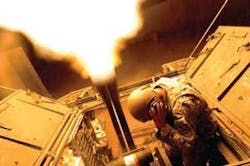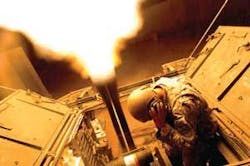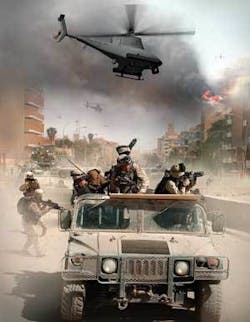Countering improvised explosive devices is not a 5- or 10-year program, but something the military needs right now as these nasty mines continue to take the lives of American fighting forces.
By John McHale
Technological evolutions in the military traditionally are done over 2- to 10-year programs, yet sometimes military leaders will shelve funding for those programs if defense contractors can provide solutions today to save warfighters in the field.
Improvised explosive devices (IEDs) provide such a scenario.
IEDs kill Americans every month and are considered to be the biggest threat facing U.S. soldiers in Iraq.
While these devices are relatively inexpensive to produce and can be trigged with a simple device like a cell phone, they can cause severe damage to American forces and civilian convoys. Even worse, sometimes they are intertwined with more conventional mines on the same route.
Defense planners initially have looked at strengthening their vehicles to improve survivability for vehicle and crew following a blast.
An example of this is the Tank Urban Survivability Kit (TUSK) Counter Improvised Explosive Device (IED) enhancements from General Dynamics Land Systems for the U.S. Army M1A1 and M1A2 Abrams main battle tanks. The TUSK IED protection kits include a ballistically reinforced minefloor and a specialized seat designed to counter the effects of IEDs.
However there are plenty of electronic solutions to counter IEDs, including jammers, minefield detection, unmanned platforms, and simulation training systems.
Broad Shield
The L-3 Communications TRL Technology subsidiary in Tewkesbury, England, has launched its next-generation Broad Shield force protection solution that counters improvised explosive devices (IEDs). L-3 TRL is a unit of the L-3 Integrated Systems Group.
A programmable IED jammer and countermeasures system, the Broad Shield Tactical Manpack (TMP) builds on the success of L-3 TRL Technology’s combat-proven Broad Shield force-protection units currently deployed by coalition forces. Approximately 50 percent lighter and smaller than its predecessor, Broad Shield TMPs retain all the original system’s flexibility-including the same frequency range, performance, mission duration, and transmit capabilities-combined with an increased ability to address simultaneous threats, L-3 officials say.
L-3 TRL Technology created this latest generation solution based on customer feedback and operational experience, as well as extensive testing of the advanced Broad Shield manpack equipment against a broad range of threats. In addition, the Broad Shield TMP also provides wideband continuous frequency coverage without any loss of systems flexibility or ease of programming.
Despite its small size, the unit can accommodate an integrated standard BB-2590 (or compatible) military battery pack. Other key enhancements include additional direct digital synthesis signal generators to generate several simultaneous jamming signals, a zeroize button, and provision for a plug-in external remote control box.
L-3 TRL has based the Broad Shield TMP design on configurable, common hardware units that can adapt to emerging threats. The Broad Shield TMP can be configured for infantrymen, vehicles, bomb disposal crews, or base protection, and can handle the diverse frequencies of remotely controlled IEDs and employs a wide range of proven jamming modes and waveforms.
Broad Shield TMP uses all available electronic jamming techniques including spot jamming, multiple-target spot jamming, and wideband noise jamming. The equipment is field-programmable, enabling new mission parameters and waveforms to be loaded into the unit from a PDA or laptop.
ASTAMIDS
Northrop Grumman’s Airborne Surveillance, Target Acquisition and Minefield Detection System (ASTAMIDS) for Future Combat Systems (FCS) is tackling the IED situation from the air. ASTAMIDS detects and locates minefields and obstacles to enable maneuver commanders to decide whether to clear or avoid them, Army officials say.
“Our baseline countermine design included some inherent RSTA [reconnaissance, surveillance, and target acquisition] and target designation applications capability in the original proposal,” says Dave Gilbert, the ASTAMIDS program manager for Northrop Grumman Integrated Systems-the prime contractor for ASTAMIDS. “This program expansion leverages those inherent capabilities with a tracking and designation capability to fulfill counter-mine and RSTA missions for the U.S. Army.”
The ASTAMIDS program will operate on the Army Future Combat System RQ-8B Fire Scout Class IV unmanned helicopter that Northrop Grumman is developing with day or night capability. ASTAMIDS carries an integrated, multi-sensor, electro-optical infrared/multi-spectral imaging payload to detect patterned surface-emplaced mines, patterned recently buried mines, and randomly scattered mines. The payload can detect obstacles, combat vehicles, and other targets, including those under camouflage.
ASTAMIDS uses quad-prism aperture-splitting technology with the aid of an integrated illuminator and target laser rangefinder and designator. The Army is developing change-detection algorithms to insert into the Future Combat System program, to address improvised explosive devices and single on-route mines by processing ASTAMIDS imagery.
“The commonality issue alone is a major benefit across all of U.S. Department of Defense manned and unmanned platform RSTA applications,” Gilbert says. “The ASTAMIDS counter-mine RSTA design can support numerous mission areas thereby providing Defense Department life-cycle cost savings with common sensor payloads and common exploitation and processing tools that are an integral part of the ASTAMIDS development program.”
ASTAMIDS is a complementary Future Combat System program and the combined countermine-RSTA role requires the support and coordination of the Army’s Project Manager, Close Combat Systems Organization, and the Future Combat System Airborne Systems Integrator, Northrop Grumman. The Army’s vision to create a multimission sensor payload has the potential of supporting emerging RSTA mission areas on several platforms for several service applications. Inherent in its design is the ability to also support other Defense Department service missions for the U.S. Navy and U.S. Air Force.
ASTAMIDS is currently in system design and develop with prototypes available for operational testing this year. It consists of two subsystems: the Airborne Payload and the Tactical Ground Segment (TGS).
The Airborne Payload (AP), provided by DRS Technologies in Parsippany, N.J., consists of Multi-Spectral Electro-Optical sensors covering the Visible and Near Infrared (VNIR) and Mid Wave Infrared (MWIR) portions of the spectrum. The AP contains mission-specific hardware, software, and firmware components installed in the FCS unmanned aerial vehicle (UAV). It collects and analyzes imagery and data and transmits the products via the Network Data Link to the FCS Ground Control Station.
The Tactical Ground Segment is installed in a modular manner using standard interfaces. It uses software to conduct mission planning, using data and information derived from Intelligence and Common Operating Picture (COP) assets and for in-flight control of the AP. The TGS analyzes retrieved imagery and data and transmits mission results to the Command, Control, Communications, Computers and Intelligence (C4I) network.
Robots
Engineers at Advanced Marine Technology Inc. in Virginia Beach, Va., (AMTI) an SAIC company, are proposing their Seeker Series robots to hunt down and destroy IEDs. Seeker Series Robots are also for law enforcement for ‘sneak and peek’ missions to check out suspicious objects and places, company officials say.
AMTI offers two models of robots-the R-500 and the R-421-that have the ability to place a charge near the IED to destroy it, AMTI officials say.
The R-500 Seeker Series has longer range and better optics than previous models. The camera and the truck are operable to plus or minus 1000 feet. The R-500 also has an added benefit of decreased maneuvering to view a suspect target, which prolongs battery life as well.
The R-500 has two cameras: a pan and tilt for the target camera and a fixed-view camera for the driving the robot. Graphics are black and white for optimum resolution. The fixed-view camera enables the operator to feel as if he is in the driver’s seat, AMTI officials say. Drive to the object in question, use the pan and tilt camera to take a better look, and if necessary, detach a disposable trailer with charge, then cruise back to a safe distance and destroy the target.
The operator can use the heads-up display for hands-free viewing or the LCD monitor for collaboration viewing. The 6-inch LCD monitor screen allows for a clean, clear view. An optional helmet-mounting viewing device is also available. The R-500 can be used over and over in the field with heavy duty shocks not only last longer but also to enable towing of a heavy charge or sensor in the disposable trailer. A heavy-duty Pelican case provides easy transport of vehicle accessories.
C-IED Trainer
Experts at General Dynamics Advanced Information Systems (GD-AIS) in Arlington, Va., have developed a laptop-based counter-IED trainer, C-IED Trainer, which enables virtual counter-IED exercises, says Robert Anschuetz, senior technical manager for training Analysis and acquisition at GD-AIS in Orlando, Fla.
The C-IED Trainer rapidly creates IED scenario vignettes for mission planning and rehearsal. It also supports an after-action review capability. The goal is to capture counter-IED lessons learned and share them across the military, Anschuetz says. The trainer uses a GoBook XR-1 Rugged Notebook from Itronix Corp., a General Dynamics company in Spokane Valley, Wash., Anschuetz says.
The C-IED has two phases-planning and mission execution. The planning phase includes receive mission, issue warning, tentative plan, initiate movement, reconnoiter, complete plan, and supervise. Mission execution enables trainees to issue commands to entire convoys direct platoon squads and fire teams while dismounted, and respond to the IED-related mission, General Dynamics official say.
In addition to IED scenarios, ambushes and sniper attacks can be programmed into the scenarios to test trainee reaction to several threats, company officials say. The main performance measures and critical tasks that trainees are evaluated are extracted from tactics and procedures trained for planning and executing IED-related missions.
Future upgrades to the C-IED include a scene creation tool and a mission planning tool, Anschuetz says. The scene creation tool will enable any incident from any location to be recreated in minutes and presented by an instructor in a mission rehearsal capability or to a student in a training capacity.
The scene creation tool will provide scenario developers fundamentals building blocks necessary to quickly create a three-dimensional terrain database. The instructor will drag and drop pieces of terrain together like “puzzle pieces,” General Dynamics officials say. Various sized roads can be constructed by linking pieces together. They can then be linked to other roads, bridges, culverts, and intersections in urban and rural settings.
The mission planning tool will enable scenario developers to create a real-world scenario based on aerial photographs, Army intelligence, or media reports, company officials say. The scenario developer will start with a terrain database that can represent different types of scenarios-urban or rural, forest or desert, Anschuetz says.
Using the terrain database the scenario developer can place the moveable and stationary objects in the scene. A top-down map representation of the terrain database and the objects will be the result. The moveable objects include friendly and enemy soldiers, civilians, and vehicles. The vehicles will include HMMVWs, trucks, and civilian automobiles.
The stationary objects that can be placed into the scenario will include objects such as mailboxes, packaged, trashcans, and IEDs. The scenario developer can place an IED anywhere in the scenario, and can program it to detonate based on time or proximity to another object in the scene.





